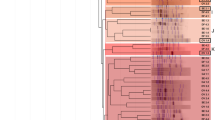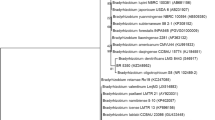Abstract
Psorothamnus spinosus seedlings were selected at random and excavated from 10×30 m quadrats along a 270 m transect in a southern Californian desert arroyo. Forty-six of the fifty seedlings excavated (92%) were nodulated. The mean number of nodules/plant was 7.0±3.6. Maximum rooting depth was 40 cm, and most (58.8%) of the nodules were found between 15 and 30 cm depth. The mean root/shoot ratio was 1.4±0.4. The rhizobial population density between 10 to 40 cm depth across all quadrats was non-detectable using a plant infection, most probable number method. All 70 isolates from field nodules were fast-growingRhizobium spp. Two colony morphologies were observed: wet, translucent, and wet, opaque. All isolates tested were effective on bothP. spinosus and another desert woody legume, mesquite (Prosopis glandulosa). Many isolates had a high relative efficiency, and seven of eight efficient isolates had uptake-hydrogenase activity. Root stimulation of the low rhizobial population found in the arroyo and subsequent root nodulation may be an important factor in seedling establishment by woody legumes in N-limited desert arroyo systems.
Similar content being viewed by others
References
Barneby R C 1977 Dalea images, memoirs of the New York Botanical Garden. The New York Botanical Garden, Bronx NY.
Date R A and Vincent J M 1962 Determination of the number of root-nodule bacteria in the presence of other organisms. Aust. J. Exp. Agric. Anim. Husb. 2, 5–7.
Eisbrenner G and Evans H J 1983 Aspects of hydrogen metabolism in the nitrogen-fixing legumes and other plant-microbe associations. Annu. Rev. Plant Physiol. 334, 105–136.
Eskew D L and Ting I P 1978 Nitrogen fixation by legumes and blue-green algal-lichen crusts in a Colorada Desert Environment. Am. J. Bot. 65, 850–856.
Felker P and Bandurski R S 1980 Uses and potential uses of leguminous trees for minimal energy input agriculture. Econ. Bot. 33, 172–184.
Garvin S and Lindemann W C 1983 A new growth technique for the most-probable-number estimation of Rhizobium. Soil Sci. Soc. Am. J. 47, 604–606.
Hartel P G and Alexander M 1984 Temperature and desiccation tolerance of cowpea rhizobia. Can. J. Microbiol. 30, 820–823.
Jenkins M B, Jarrell W M and Virginia R A 1986 Profiles of indigenous mesquite-nodulating rhizobial population densities with depth in the Chihuahuan Desert. Agron. Abst. p. 181.
Jenkins M B, Virginia R A and Jarrell W M 1987 Rhizobial ecology of the woody legume mesquite (Prosopis glandulosa) in the Sonoran Desert Appl. Environ. Microbiol. 53, 36–40.
Jordan D C 1984 RhizobiaceaeIn Bergey's Manual of Systematic Bacteriology Vol. 1. Eds. N R Krieg and J G Holt. pp. 235–256. Williams and Wilkins, Baltimore.
Kennedy L D and Greenwood R N 1982 6-Phosphogluconate and glucose-6-phosphate dehydrogenase activities, growth rate, and acid production as taxonomic criteria for Rhizobium. N.Z.J. Sci. 24, 361–366.
La Favre J S and Focht D D 1983 Comparison of N2-fixation and yields inCajanus cajan between hydrogenase positive and hydrogenase negative rhizobia byin situ acetylene reduction and direct15N partitioning. Plant Physiol. 72, 971–977.
Lambert G R, Cantrell M A, Hanus F J, Russell S A, Haddad K R and Evans H J 1985 Intra and interspecies transfer and expression ofRhizobium japonicum hydrogen uptake genes and autotrophic growth capability. Proc. Natl. Acad. Sci. USA. 82, 3232–3236.
Langkamp P J, Lindsay B S and Dalling M J 1979 Nitrogen fixation (acetylene reduction) byAcacia pellita on areas restored after mining at Groote Eylandt, northern territory. Aust. J. Bot. 27, 353–361.
Marshall K C 1964 Survival of root-nodule bacteria in dry soils exposed to high temperatures. Aust. J. Agric. Res. 15, 273–281.
Martin W P 1949 Observations on the nodulation of leguminous plants in the southwest. U.S.D.A. Soil Cons. Serv. Regional Bull. 107 Plant Study Series 4.
Martinez-De Drets G and Arias A 1972 Enzymatic basis for differentation of Rhizobium into fast-and slow-growing groups. J. Bacteriol. 109, 476–470.
Rainbird R M, Craig A A, Pate J S and Sanford P 1983 Significance of hydrogen evolution in the carbon and nitrogen economy of nodulated cowpea. Plant Physiol. 71, 122–127.
Rundel P W, Nilsen E T, Sharifi M R, Virginia R A, Jarrell W M, Kohl D H and Shearer G B 1982 Seasonal dynamics of nitrogen cycling for a Prosopis woodland in the Sonoran Desert. Plant Soil. 67, 343–353.
Ruiz-Argueso T, Hanus J and Evans H J 1978 Hydrogen production and uptake by pea nodules affected by strains ofRhizobium leguminosarum. Arch. Microbiol. 116, 113–118.
Schubert K R and Evans H G 1976 Hydrogen evolution: a major factor affecting the efficiency of nitrogen fixation in nodulated symbionts. Proc. Nat. Acad. Sci. U.S.A. 73, 1207–1211.
Shearer G, Kohl D H, Virginia R A, Bryan B A, Skeeters J L, Nilsen E T, Sharifi M, and Rundel P W 1983 Estimates of N2-fixation from variation in the natural abundance of15N in Sonoran Desert ecosystems. Oecologia 56, 365–373.
Vincent J M 1970 A Manual for the Practical Study of Root-Nodule Bacteria. International Biological Programme Handbook No. 15, Blackwell Scientific Publications, Oxford.
Virginia R A 1986 Soil development under legume tree canopies. For. Ecol. Manage. 16, 69–79.
Virginia R A, Baird L M, LaFavre J S, Jarrell W M, Bryan B A and Shearer G 1984 Nitrogen fixation efficiency, natural15N abundance and morphology of mesquite (Prosopis glandulosa) root nodules. Plant Soil 79, 273–284.
Virginia R A and Jarrell W M 1983 Soil properties in a mesquite-dominated Sonoran Desert ecosystem. Soil Sci. Soc. Am. J. 47, 138–144.
Virginia R A, Jarrell W M, Rundel P W, Kohl D H and Shearer G 1988 The use of variation in the natural abundance of15N to assess symbiotic nitrogen fixation by woody plants.In Stable Isotopes in Ecological Research. Eds. P W Rundel, J R Ehleringer and K A Nagy. Ecological Studies Series, Springer-Verlag. (In press).
Virginia R A, Jenkins M B and Jarrell W M 1986 Depth of root symbiont occurrence in soil. Biol. Fert. Soils 2, 127–130.
Wang R T 1980 Amperometric hydrogen electrode. Methods in Enzymology 69, 409–413.
Author information
Authors and Affiliations
Rights and permissions
About this article
Cite this article
Jenkins, M.B., Virginia, R.A. & Jarrell, W.M. Rhizobial ecology of the woody legumePsorothamnus spinosus in a Sonoran Desert Arroyo. Plant Soil 105, 113–120 (1988). https://doi.org/10.1007/BF02371148
Received:
Revised:
Issue Date:
DOI: https://doi.org/10.1007/BF02371148




